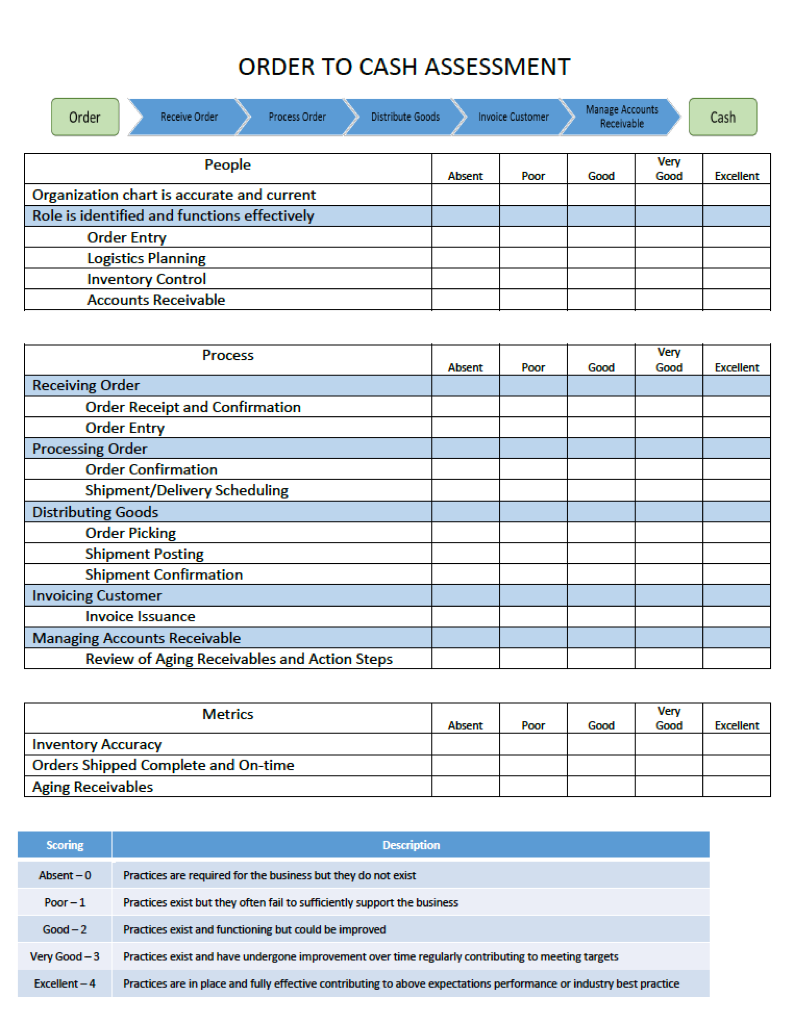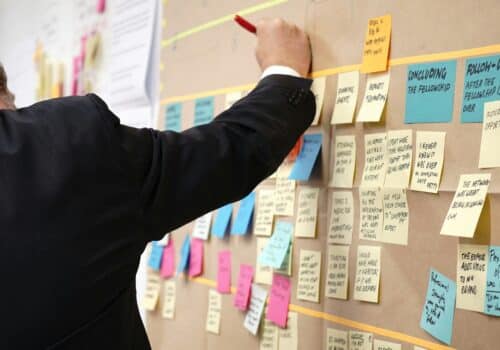ERP Readiness Series: How to Conduct a Business Process Assessment
In our last post in the ERP Readiness Series, we reviewed a model of nine business processes that we use as we work with clients to determine their level of ERP readiness. This week, we look more closely at how to conduct a readiness assessment using the Order-to-Cash Process as an example.
At SYTE, when we assess business processes, we analyze a series of criteria across three separate dimensions: people, process, and metrics, and we assign each criteria a score from 0 (absent) to 4 (excellent). Here is what the measurement tool actually looks like for the Order to Cash process:
The 3 Dimensions of Business Processes
Processes don’t happen in a vacuum. People interact with business processes on a daily basis. People execute business processes, so it is important to ask whether the right people are doing the right things to effectively execute their part of a process? It goes without saying that roles change from process to process even if the people involved are the same—this is true in startups and small businesses where people have multiple roles. The point is not who is filling the role, the point is, is the role clearly defined, and is the person in that role being effective?
Notice, again, the five blue chevrons that point the way from Order to Cash in the process above. We wrote in our last post that each chevron, or step, in the process can be made up of multiple sub-processes. And, in our example, you’ll see that is the case. Under Receive Order, you’ll find Order Receipt and Confirmation and Order Entry, and so on.
Lastly, as people execute each of these processes, data is generated which can (and should) be turned into metrics. In general terms, metrics offer a view into a process after it has been executed. Metrics answer the question, how did it (the process being measured) go? In the Order to Cash process, we look at three metrics: Inventory accuracy, Orders shipped complete and on time, and aging receivables.
The Score
As we look at each criterion under the dimension described above, we assign it a score from 0 to 4 as follows.
0 – Absent: Practices are required for the business, but they do not exist.
1 – Poor: Practices exist but often fail to support the business.
2 – Good: Practices exist and are functioning but could be improved.
3 – Very Good: Practices exist and have undergone improvement over time, regularly contributing to meeting targets.
4 – Excellent: Practices are in place, fully effective, and contribute to “above-expectations” performance or industry best practice.
Scoring the criteria on the assessment sheet accomplishes two things, it identifies which processes your business is doing well, and it shows you where there are gaps in your business processes that need to be addressed.
Process Readiness in the ERP World
Doing this sort of “process grading” is an important step to complete prior to installing a new ERP system or upgrading an existing one. Finding gaps in your processes while implementing an ERP system will add complexity to the implementation and could cause costly delays; it will also add to the stress to your Core Team. Finding and addressing gaps in your business processes before starting an ERP implementation will give your team the opportunity to improve business processes without the additional stress of being under an ERP implementation deadline.
You can conduct your own initial assessment following our ERP Readiness Assessment right here. And if you need more help, just give us a call!
ERP Readiness Self-Assessment
Is your organization ready for a new or upgraded ERP solution? Find out with this complimentary self-assessment.
Doing Business Better
You strive for excellence, believe in your people, and want to do things right the first time. And you know that you need help to get to the heart of your business challenges and make the best choices for the future of your privately held manufacturing and distribution company. That’s where we come in.
We help you focus and find exactly the right path to accelerated growth and sustainable success — from your people to your processes to your ERP software.




